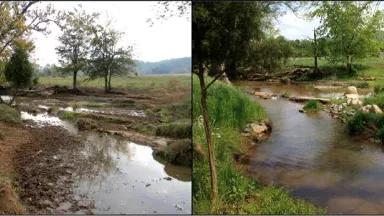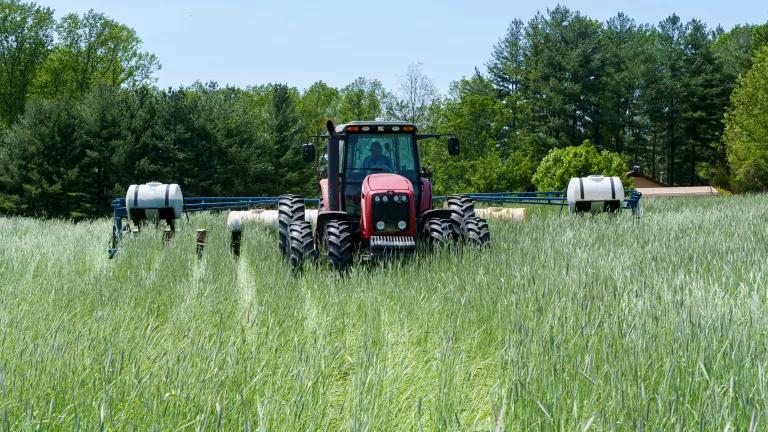As the market for better beef expands, NRDC is working to reduce the environmental hoofprint of beef cattle grazing and feedlot operations by working with multi-stakeholder partners to develop scientifically credible yet practical sustainability standards for beef buyers—including supermarkets, restaurants, institutions from schools to parks, and families.
These market-driven engagement tools will ensure that the health of America's grazing lands, feedlot and feed crop production practices, animal welfare, and worker safety are improved industry-wide. They will also ensure that meat producers use antibiotics responsibly because the overuse of antibiotics is leading to antibiotic resistance, an emerging health threat for children and other vulnerable populations.
We all have a role to play in creating a better beef supply chain, and in shrinking our collective hoofprint.
Where is the better beef?
"Sustainable" has become an overused and often vague term. Therefore, we opt for the word "better" in recognition of the values of continuous improvement—from those just beginning to use better management practices to those on the vanguard. Even though the demand for better beef is growing, only a small percentage of U.S. cattle are produced using sound natural resource management.
Businesses and consumers can make a difference in advancing better beef by voting with their purchases, rewarding verifiably better beef producers with more business. Beef buyers from McDonald's and Walmart to Chipotle and Whole Foods are actively seeking ways to recognize better beef sources in the marketplace. Here's why their choices—and yours—are so important.
The beef on beef and the benefits of improving the supply chain
The U.S. beef supply chain suffers from poor management practices that impact our climate and degrade our grazing lands while adversely influencing public health, animal welfare, and worker safety. Learn more about the impacts of poorly managed grazing ranches, farms, and feedlots.
Fortunately, an extensive body of science has shown that improving supply chain management has the potential to dramatically benefit ecosystem health across the country. This is because, for example, well-managed grazinglands provide society with economically valuable "ecosystem services", including biodiversity, sequestered carbon, filtered nutrient runoff, recharged ground and surface waters, recreational opportunities, and scenic landscapes. Learn more about these benefits.
The quest for better beef
Major food buyers (e.g., supermarkets and restaurants) are pursuing new marketing opportunities to appeal to "green" consumers who seek "sustainable" products that they can trust to be "better" for our environment and public health. This new demand for verified sustainable beef is a potentially game-changing development. NRDC believes that working with these buyers to achieve this goal will incentivize transitions to better production practices by driving more business to both the best-performing producers and those who are continuously improving.
What's really "better" in the confusing world of beef marketing claims?
While more and more brands claim to offer better beef products, it is difficult to determine whether marketing claims are accurate or whether they are unsubstantiated "greenwash." For example, some beef marketed as "sustainable" is explained as "natural." Such terms fail to confirm whether cattle were produced on well-managed grazing operations and responsibly managed feedlots. On the other hand, some retailers like Whole Foods and brands like Estancia are making more transparent claims and are taking verified actions to improve their supply chains. While these are important steps in the right direction, they still fail to comprehensively address whether beef is produced in a manner that protects our environment and public health, maintains high animal welfare, and treats ranchers, farmers, and workers fairly.
NRDC analysis: most beef labels verify only part of the solution
To help major buyers recognize verifiably better sources of beef, NRDC completed an exhaustive scientific and market-informed analysis of the main independent beef production standards. We concluded that there is currently no comprehensive distinguishing mechanism with broad stakeholder support available to U.S. beef buyers and producers.
For example, to avoid toxic pesticides, synthetic fertilizers, and non-therapeutic antibiotics, buyers can look for USDA organic-certified beef. To purchase beef from producers who treat their animals humanely, buyers can seek Animal Welfare Approved or Whole Foods' GAP program. For beef that comes from cows produced entirely on grazing lands (avoiding the impacts of feedlot production), buyers can purchase grass-fed. But buyers beware: a grass-fed label is about what animals are fed and doesn't distinguish whether the beef was produced on well-managed, climate-friendly ranches that are not overgrazed—and thus have vibrant soils, clean streams and thriving native plant and wildlife biodiversity.
All of these distinctions may confuse buyers, who need one simple way to recognize beef produced using responsible practices through every step of the supply chain. We need a comprehensive standard that verifies beef that can be trusted to be better during all stages of its production.
How NRDC is helping improve beef production
NRDC experts have found only one comprehensive program serving producers based in the United States: Food Alliance. Yet it is still small and needs both partners and resources to meet the tremendous challenges posed by major U.S. beef supply chains. Thus, building on their foundation, we are partnering with Food Alliance, Rainforest Alliance, and a growing number of stakeholders to help define and develop a new comprehensive program—including market driven engagement tools -– for better beef production in the United States. This new program will account for the health of America's grasslands and other grazed ecosystems, how ranchers and farmers grow grass and feed crops, how feedlots are managed, and whether cattle are treated humanely and workers are treated fairly. Since 97 percent of U.S. beef is fattened for slaughter on feedlots, we can and must reduce the impacts of these facilities by promoting the best science and practical knowledge we possess to improve their management, even as we seek to promote and improve management of grass-based systems.
Led by NRDC's Center for Market Innovation, which specializes in channeling capital to achieve more sustainable outcomes, our vision is to collaborate with multi-stakeholder partners to:
- define "better beef" for the United States by developing rigorous yet practical market-driven engagement tools that build on existing programs, starting with the Food Alliance cattle standards,
- organize NGOs, ranchers, buyers, and consumers around this program to advance its implementation in supply chains, and
- facilitate support systems that enable participating producers to transition to better practices and reap triple bottom-line benefits (i.e., technical assistance and training, financing, research, and monitoring and evaluation to ensure real results).
How you can help
It is clear that creating a better beef supply chain can dramatically benefit a vast portion of our nation's landscape. By choosing better beef, you are supporting the pioneers of better beef production.




